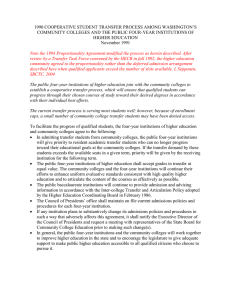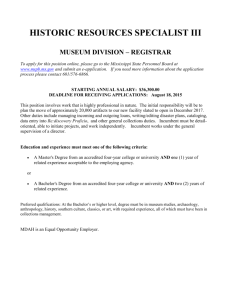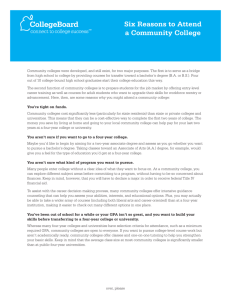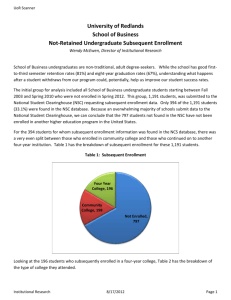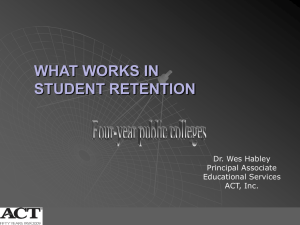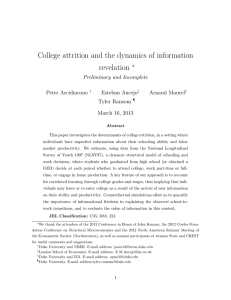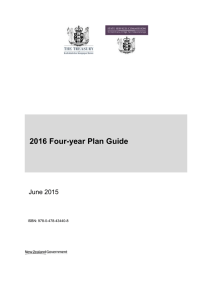Share What Works - College of Southern Nevada
advertisement
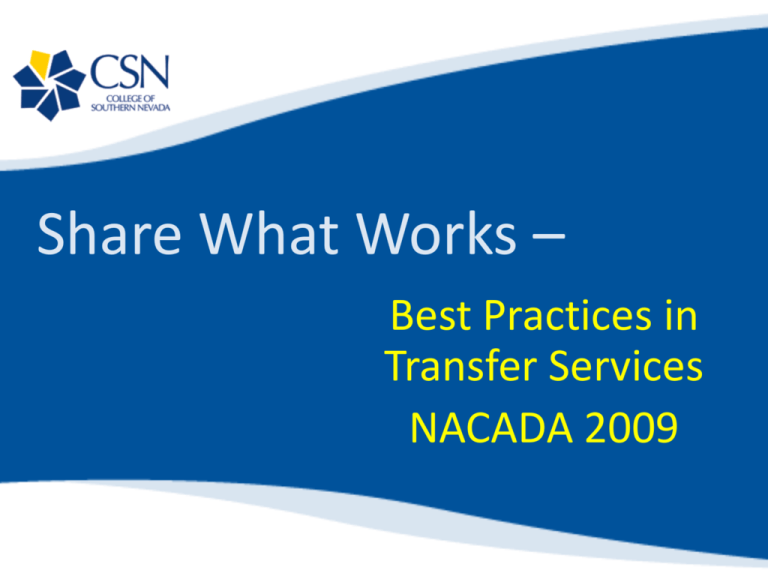
Share What Works – Best Practices in Transfer Services NACADA 2009 Presentation Agenda • Introductions & Definitions • Review of Literature • Best Practices • Group Activity We are… College of Southern Nevada, Counseling Department • Jason Cifra, Director of Counseling • Jana Wolf, Counselor – Transfer Services Coordinator, Cheyenne • Lisa Cohen, Counselor – Transfer Services Coordinator, Henderson • Nadine Huyck, Advisor – Transfer Services Coordinator, Charleston and UNLV Transfer Liaison Why is Earning a Degree Important? • United States needs to produce 64 million additional degrees between 2005 and 2025 to meet domestic workforce needs—a gap of 16 million degrees. • A significant portion of the adult population in most states has some college but no degree, particularly within minority groups, which suggests an area of focus for increasing degree attainment. Why is Earning a Degree Important? • The United States ranks tenth among industrialized nations in the percentage of 2534 year olds with an Associate’s degree or higher. • Ranks near the bottom of industrialized nations in the percentage of entering students that complete a degree program. • Where older adults are more educated than younger adults. Why is Earning a Degree Important? • Racial and ethnic disparities in degree completion and educational attainment affect all states. • These same groups are the largest growing population in many states. Definitions of Transfer “Transfer can be defined as a transition between post-secondary institutions, in which the second institution (the receiving institution) grants the student credit for coursework taken at the first institution (the sending institution).” McCormick and Carroll (1997) Definitions of Transfer Freshman transfer students have: • Taken fewer than 24 transferable credits. • Earned a minimum 2.5 GPA or higher from a regionally accredited college or university. • Maintained good academic standing with the last institution attended . Definitions of Transfer Traditional transfer students have: • Taken at least 24 transferable credits. • Earned a minimum 2.5 GPA or higher from a regionally accredited college or university. • Maintained good academic standing with the last institution attended . Types of Transfer • Vertical (2-4) Two-year to four-year institutions. • Horizontal (2-2; 4-4) Two-year to twoyear or four-year to four-year . • Reverse (4-2) Four-year to two-year. • Gypsy/Multiple (?-?-?) Attending more than two institutions. (Jacobs, 2004) Who are the Transfer Students? • Grubb (1991) reported that a considerable number of minority students who receive a baccalaureate degree started at two-year institutions. • Cohen and Brawer (2003) suggest that the students least likely to transfer are adult students who attend community colleges parttime. Who are the Transfer Students? In their NCES national study based on longitudinal data, Peter and Cataldi (2005) found that nearly twice as many younger, dependent, traditional-age students (58%) attended more than one institution compared to independent, non-traditional students (27%). Who are the Transfer Students? • Eggelston and Laanan (2001) reported that nearly 50% of community college transfer students are from CTE programs. • Many community college students transfer prior to earning an associates degree (Cohen & Brawer, 2003; Dougherty, 1992; McCormick & Carroll, 1997; Townsend and Ignash, 2000). Who are the Transfer Students Classic Transfer and “Swirling” • For traditional aged students, transferring from a community college to a four-year institution is a positive factor in BA degree completion. • This is also true of four-year-to-four-year college transfer (though not as significant). • Swirling in and out of institutions (whether CC and/or four-year is negative) (College Board 2008). Student Challenges Community college students transferring to a four-year institution have been well documented that they may experience a number of academic and social adjustment challenges (Berger & Malaney, 2003; Britt & Hirt 1999; Cedja, 1994; 1997; Diaz, 1992; Graham & Hughes, 1994; House 1989; House & Keely 1993; Laanan 1996; 1998; 2001; 2004; Townsend, 1993; 1995; Townsend & Wilson, 2006). Student Challenges “The drop out rate is high [for community college students] and for students who decide to transfer to senior institutions, they experience a difficult adjustment process” (Laanan, 2003). Student Challenges Nowak (2004) interviewed 23 community college transfer students and eight faculty and found: – That often the four-year institution made assumptions that students transferring from community colleges had similar experiences, when in fact community colleges are vastly different. – Perceived that they had to search things out on their own at the university and did not feel that they knew many people on campus . Student Challenges Bauer & Bauer (1994) surveyed 92 community college transfer students and reported: • Nearly 33 percent experienced difficulty with making friends at the university. • 31 percent shared they struggled to meet new people. • 30 percent reported personal self confidence issues after transferring and had difficulty “fitting in”. Student Challenges Gumm (2006) found that the community college transfer student’s interaction with peers was a high social predictor of transfer student’s Persisting the following semester. Successful Transfer Indicators/Factors! • • • • • • Credits in collegiate math. Credits in summer session. Continuous enrollment. Minimal no penalty repeats/withdrawals from courses. More units completed at the community college. “Classic”(Junior) transfer (Adelman 2006). Best Practice Principles • Establish transfer to a four-year institution as a high institutional priority. • Identify and invest in core resources for transfer at the institutional level. • Clarify state policy and plans for 2/4 transfer, and set goals and measures for performance. • Ensure that articulation and credit transfer agreements are in place. Best Practice Principles • Develop intensive academic support programs based on models of “academic excellence” (e.g., academic counseling, peer tutoring, and reciprocal learning techniques.) • Offer a rigorous curriculum for all students that includes writing, critical thinking, mathematics, and the sciences. • Establish strong community and family linkages that foster intellectual stimulating, secure, and culturally rich environments for students on and off campus. Best Practice Principles • Establish partnerships with public and private receiving institutions to create streamlined transfer processes and activities such as priority admission, orientation, and advising. • Develop training and methods of communicating information to students and staff. Best Practices in Action • SITE is a six-day residential academic program for educationally disadvantaged students. The program motivates and prepares firstgeneration, low income, and underrepresented community college students to transfer to a four-year institution. • SITE is held at UCLA. Best Practices in Action Transfer FIGS – University of Oregon • Transfer First-Year Interest Groups are designed for transfer students with major or pre-major status, but open to all transfers. • Transfer FIGS are promoted during orientation. • Transfer FIGS have a transfer student Teaching Assistant to help address the unique needs of transfer students transitioning to campus. Best Practices in Action Transfer Mentors/Ambassadors – University of North Texas • Transfer Ambassador Program connects new transfer students with current UNT transfer students. • Transfer Ambassadors attend transfer orientation sessions and help personally mentor new transfer students. • Transfer Ambassadors participate in a "Transfer Panel" to answer questions at orientation. Best Practices in Action Transfer Seminars • Radford University – UNIV 100-T – Transfer student academic transcript evaluation – Getting involved • NIU – UNIV 201 –Transfer Transition course – 1 –credit, 12-week graded course – Extended orientation – academic & social aspects of the community Best Practices in Action Orientation Options • University of Utah – A 3-hour transfer orientation – A 6-hour comprehensive transfer orientation – An overnight transfer orientation – A combined (freshmen & transfer) orientation – Mini orientations (during the first day of classes) Best Practices in Action • University of California, Santa Cruz – Dedicated living-learning communities or housing for Transfer Students. • Tau Sigma – Transfer Student Organization – – – – 50 chapters nationwide 14 Scholarships of $500 to $2,500 Transfer student BBQ Open house and transfer days Best Practices in Action University of Central Florida – Mission Statement Transfer and Transition Services provides assistance, referrals, and advocacy to enhance students' opportunities for strong academic preparation, a smooth transition to UCF, and successful progress toward graduation. We provide these services to transfer and transitioning undergraduate students through academic and transition advising, programming for students and advisors, coordination of articulation agreements, and through publications and other communications for all constituents. Best Practices in Action Dallas County Community College – Mission Statement The mission of the Transfer Services/Articulation and University Relations office is to ensure seamless transfer of credit courses from DCCCD. The Transfer Services office will provide information to students, advisors/counselors, staff and faculty on articulation agreements, course transfer, academic planning and related student services through the development and maintenance of the transfer Web site and organization of staff development programs. Best Practices in Action • Ensuring Transfer Success (ETS) Counselor Institutes developed by the University of California and California Community Colleges to train advisors, counselors, and directors. Best Practices in Action • Nevada System of Higher Education Common Course Numbering and guaranteed admission to UNLV, UNR, and NSC with completion of Associate of Arts, Business, and Science (transfer degrees). What’s Happening at Your School? What’s Up at CSN? 1. Creation of Transfer Center and Transfer Services Coordinators. 2. Transfer partnerships with local public, private, and out-of-state institutions. 3. Articulation worksheets for all transfer programs. 4. Transfer Website. 5. Transfer Partner visits, workshops, and cross-training. 6. Strategic Planning aligned with Institutional Transfer Goals. What’s Up at CSN? CSN Transfer Survey Results: 1. Most have thought about transfer within their first two semesters. 2. Top Interests: Transfer Process, Application, “Who can I talk to?”, “How soon can I apply?”, Financial Aid, Transfer Credits, and “Someone to help me out!” 3. Top Factors: Cost, Distance, and Location. 4. Preferred Methods of Communication: Phone and email. 5. Age Range: Mostly 15-21, but all ages represented. 6. Number of Participants: 191. How Advisors and Counselors Can Help! • Interaction with students no later than the first term at a community college to develop an academic plan of action for successful transfer. • Sustained intervention is the key by faculty and staff at community colleges and four-year transfer destinations. • Ensure that transfer is perceived by students as expected and attainable. How Advisors and Counselors Can Help! • Create an environment of belonging in which students feel stimulated to achieve at high academic levels. Be aware of “transfer shock” that students have may experience. • Collaborate with counterparts at receiving institutions for training, information sharing, and professional development. • Collaborate with all stake holders in developing articulation plans and transfer agreements. We Need to Encourage Students To: • • • • • • • Stay continuously enrolled (even if part-time!) Complete at least 20 units in first year Use summer sessions strategically to build and maintain momentum. Complete at least one course in collegiate mathematics. Complete at least one course in English composition. Completion as many units as possible at the community college before transfer Don’t “swirl”. We Need to Support Policies That: • • • • • • Implement a minimum progress requirement (to encourage continuous enrollment). Tighten up withdrawal/repeat rules. Encourage skill building in collegiate math and English composition. Encourage completion of major preparation. Support transfer at the junior level allowing students to complete both GE and prepare for a major. Expand advising services advising tools, and counselor professional development. Advice to Receiving Institutions • See Checklist of Best Practices example from Best Practice Guide - A Resource for Receiving Institutions (British Columbia Council on Admission and Transfer, 2008) The presentation today and the resources used are available online. Please visit us at: www.csn.edu/transfer Special Thanks to Scott Peska, M.A., Associate Director of First-Year Experience and Orientation and Coordinator of the First Year Connections Programs, Northern Illinois University for sharing his resources.

